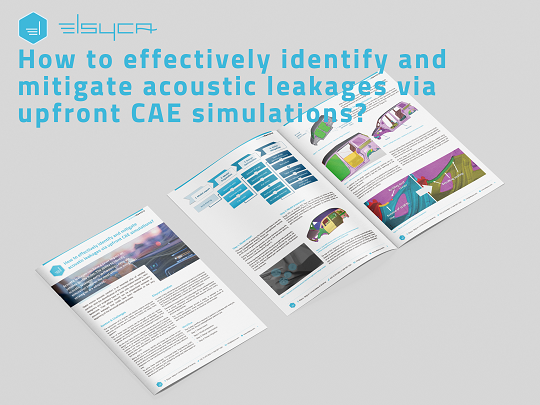
How to effectively identify and mitigate acoustic leakages via upfront CAE simulations?
Acoustic leakages can have a severe impact on vehicles' quality index. The ability to identify acoustic leakages early in the design cycle via simulation ensures the most effective mitigation strategies are adopted.

Cabin interior acoustic comfort is an essential pillar of vehicles’ comfort. With the electrification of the transportation industry, NVH designers and engineers have to deal with new interior acoustic landscape. Their efforts should not be jeopardized because of acoustic leakages that could have been identified at the very beginning of the structural design process.
Context & Challenges
The replacement of IC engines with electric engines introduces new acoustic sources and makes previously masked noise sources (exterior tire and wind noise or interior AC noise) more apparent.
Part of these noise sources can be brought inside the vehicle via acoustic leakages, also known as airborne leakages. These leakages can have a significant impact on the quality index of the
vehicle, affecting both the driver’s and passenger’s experience.
On the other hand, airborne leakages are actually part of a vehicle design: the interior cavity cannot be pressurized and it is required to have an air leakage from the passenger compartment to the outside of the vehicle. Therefore, NVH engineers do have to work closely with body and chassis designers to ensure that nondesired leaks are identified and dealt with as early as possible in the design cycle.
Being able to measure, identify and locate the number of nondesired leaks is a cumbersome task, considering the complexity of the BIW structure and its components. When a leak is found, it can be difficult to assess how and where to seal it, so that it can be integrated into the manufacturing process in the most effective way.
To solve these challenges, Computer-Aided Engineering (CAE) solutions are used in order to provide time- and cost-effective methods in assessing and mitigating recognized leaks based on
the structural design of a BiW.
Elsyca’s solution
In order to help vehicle designers and NVH engineers to collaborate as early as possible on the identification of undesired air leakage and the design of effective mitigation systems, Elsyca introduced the Elsyca LeakageMaster, a robust and dedicated CAE solution for acoustic leakage paths identification and mitigation.
Developed in cooperation with Volkswagen, Elsyca LeakageMaster is a unique simulation technology able to identify possible acoustic leakages and evaluate countermeasures without costly physical approaches.
The workflow, articulated around 4 steps, is detailed in the following paragraphs, where required inputs and outcomes of each step are illustrated on an industrial vehicle model.
